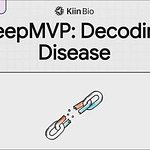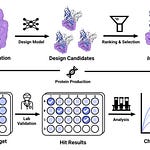A collaborative team from MIT and EPFL has developed BoltzDesign1, a novel computational framework that repurposes all-atom structure prediction models to design protein binders for diverse molecular targets. By inverting the Boltz-1 model (an open-source analog of AlphaFold3), BoltzDesign1 enables efficient, high-quality protein design without requiring model retraining, opening new avenues for drug discovery, biosensors, and enzyme engineering.
Key Innovations
Efficient Computational Framework:
Leverages only the Pairformer and Confidence modules of Boltz-1, bypassing computationally expensive diffusion steps.
Optimizes atomic distance probability distributions (distograms) instead of single structures, reducing memory usage and gradient issues.
Employs a four-stage optimization process to transition from continuous sequence space to one-hot encoding, enhancing structural robustness.
Enhanced Structural Diversity and Accuracy:
Achieves 76% precision in inter-chain contact prediction, outperforming structure module-based methods.
Generates binders with higher in silico success rates (AF3 pLDDT >0.7, ipAE <10) than RfDiffusionAA across small molecules (IAI, FAD, SAM, OQO).
Designs exhibit greater structural diversity (average TM-score 0.36 vs. 0.46 for RfDiffusionAA) and tunable secondary structures via helix loss weights.
Flexible Ligand Modeling:
Uniquely models flexible ligand conformations during optimization, unlike fixed-ligand approaches.
Enables de novo design for targets with unknown conformations, critical for complex interactions (e.g., nucleic acids, post-translational modifications).
Broad Biomolecular Applications:
Successfully designed binders for small molecules, metal ions (Zn²⁺, Fe³⁺), B-DNA, and post-translationally modified proteins (phosphorylated PCNA, Smad2, glycosylated CD45).
Demonstrated cross-model consistency (RMSD <2 Å) and improved docking scores (9.3% of SAM designs outperformed native binders).
Integration with Existing Tools:
Combines with LigandMPNN for sequence refinement, achieving higher interface residue conservation (Supplementary Fig S1).
Optional interface fixation during redesign boosts success rates by 15-20% (Supplementary Fig S2).
Limitations and Future Directions
Current constraints: No template integration, limited nucleic acid MSA support, and potential overfitting risks.
Next steps: Experimental validation, incorporation of 3D structural data, and extension to flexible targets (e.g., RNA, multi-modified proteins).
Impact
BoltzDesign1 represents a paradigm shift in computational protein design, offering a resource-efficient, generalizable approach to engineer biomolecular interactions. Its ability to handle diverse targets—from metals to covalent modifications—positions it as a versatile tool for therapeutic development and synthetic biology.
Code and data are available at GitHub.











